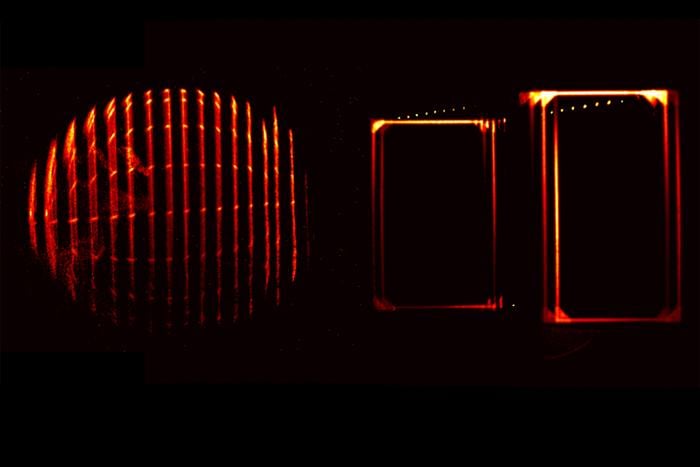For the first time ever, physicists have demonstrated a century-old Einstein-related prediction that objects moving near light speed appear rotated rather than compressed when photographed. Using innovative laser technology that effectively slowed light to walking speed, researchers at TU Wien and the University of Vienna have visualized the elusive Terrell-Penrose effect, transforming our understanding of how we perceive objects moving at relativistic speeds.
Proving a 65-Year-Old Prediction That Challenges Our Visual Intuition
Einstein’s special relativity tells us that objects moving near light speed become compressed in their direction of travel – a phenomenon called Lorentz contraction. But in 1959, physicists James Terrell and Roger Penrose (who later won the 2020 Nobel Prize) independently made a counterintuitive prediction: we wouldn’t actually see this compression in a photograph. Instead, fast-moving objects would appear rotated.
Why hasn’t anyone observed this effect before? Put simply, it’s incredibly difficult to photograph anything moving at relativistic speeds – until now.
The Innovative “Slow Light” Solution
“We moved a cube and a sphere around the lab and used the high-speed camera to record the laser flashes reflected from different points on these objects at different times,” explained Victoria Helm and Dominik Hornof, the students who conducted the experiment.
“If you get the timing right, you can create a situation that produces the same results as if the speed of light were no more than 2 metres per second.”
This breakthrough technique effectively reduces light’s speed from its normal 300 million meters per second to just 2 meters per second – slower than a person walking – making previously invisible relativistic effects observable in a laboratory setting.
How Relativistic Photography Tricks Our Eyes
The effect occurs because light from different parts of a moving object doesn’t reach our eyes or camera simultaneously. When photographing an extremely fast-moving cube, for example:
- Light from the back corner travels farther than light from the front corner
- This means the back corner’s light was emitted earlier in time
- During this time difference, the object has moved to a new position
- This time-of-flight difference creates the appearance of rotation
As Professor Peter Schattschneider from TU Wien explains, “This makes it look to us as if the cube had been rotated.” The team’s findings align perfectly with theoretical predictions, showing that a cube appears twisted while a sphere remains spherical but with its features seemingly rotated around an axis.
Where Art Meets Science: The Unusual Origins of the Experiment
Interestingly, this groundbreaking scientific achievement emerged from an art-science collaboration. The project began with artist Enar de Dios Rodriguez exploring ultra-fast photography and the “slowness of light” concept alongside researchers from Vienna’s universities.
Using picosecond laser pulses (trillionths of a second) and cameras with gating times as short as 300 picoseconds, the team developed a technique that captures reflected light from precisely positioned objects. By carefully timing these captures and combining them into synthesized “snapshots,” they created the world’s first visual demonstration of the Terrell-Penrose effect.
The researchers animated these snapshots into short videos showing objects moving at virtual speeds of 0.8c (80% light speed) for a cube and 0.999c (99.9% light speed) for a sphere.
Real-World Implications: Expanding Our Understanding of Relativity
Could this new technique visualize other famous thought experiments in relativity? The researchers believe so. In their paper published in Communications Physics, they suggest their method could potentially demonstrate other unobservable relativistic phenomena, including Einstein’s famous “train” thought experiment that reveals the constancy of light’s speed.
The study also celebrates the centennial of physicist Anton Lampa’s 1924 paper, which first explored how an observer would visually perceive relativistic length contraction – work that laid the foundation for the Terrell-Penrose predictions 35 years later.
What makes these findings particularly significant is how they bridge the gap between mathematical theory and visual intuition. Einstein’s relativity has always challenged our everyday understanding of physics, but this experiment provides a tangible way to see these abstract concepts in action.
As we continue exploring the universe’s fundamental properties, this innovative intersection of art, photography, and physics reminds us that even century-old scientific questions can yield new insights when approached with creative experimental techniques. And sometimes, to truly see the universe as it is, we need to slow down light itself.
If our reporting has informed or inspired you, please consider making a donation. Every contribution, no matter the size, empowers us to continue delivering accurate, engaging, and trustworthy science and medical news. Independent journalism requires time, effort, and resources—your support ensures we can keep uncovering the stories that matter most to you.
Join us in making knowledge accessible and impactful. Thank you for standing with us!

